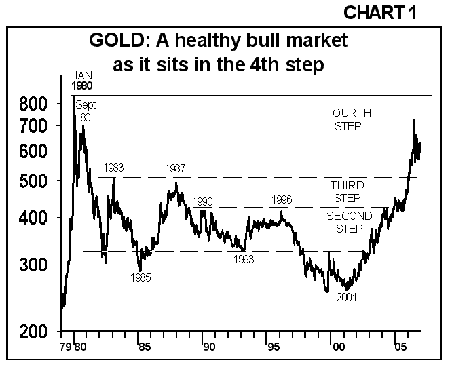
Gold, silver, their shares and the resource shares have finally started to rise. It took a while and for many, the five month correction from May to October seemed endless.
Granted, this correction was the sharpest decline in the bull market, which is what made it feel endless but long corrections can be normal. Take 2005, for example, when gold corrected from December 2004 to July 2005. But this quiet time was the calm before the storm prior to gold really taking off and capturing world attention when it soared for months, peaking last May at a 26 year high.
The fact that the best rise in the bull market was followed by the sharpest decline is not unusual, and it’s not bad because gold stayed bullish all along above its 65-week moving average.
This moving average has been the key in identifying gold’s major uptrend since 2001. It’s now at $560, which is essentially at the June and October lows. This means these lows are now also a key support area for gold. As long as gold stays above $560, the major trend is up.
Why gold is an unusual commodity
Many call gold the odd commodity. It’s different, it’s a monetary metal, it’s special, it’s a safe haven and it’s emotional because it moves with uncertainty, which is probably why it’s called odd. It rises when the economic system is unsound. It rises when the reserve currency of the world is in trouble. It rises during geopolitical tension and war. It basically rises during bad times, which is why central bankers don’t like to see a soaring gold price… it’s a threat to the monetary system.
Gold also rises during inflationary times but it can also rise during deflationary times. The main examples were of course the inflationary 1970s, and gold rose in the deflationary 1930s too. The important factor during any economic problem is the dollar, the world’s reserve currency. A falling dollar is a primary reason why gold rises. Other factors will then add fuel to the rise.
Most impressive is the slow change that’s been occurring in recent years. Many countries are now buying other currencies, mainly the euro and yen, and gold as they adjust their large dollar holdings. This is probably the biggest change that will cause gold to soar because if this tendency continues to grow, the dollar will fall sharply. And the uncertainty will cause gold to rise further in other currencies as well.
Central banks hold huge gold reserves. Any selling by Western central banks could be absorbed by Asian central banks as they build up their own gold reserves. The bottom line is, as long as gold stays in a bull market, the more central banks will want to accumulate it.
Plus, demand is growing from investors and jewelers. India is the latest example as they are again proving to be big buyers of gold for their November and December wedding season. As of last year, India accounted for 23% of the global gold jewelry market, whereas the U.S. only accounted for 12%. Investors are also buying more gold now, especially through the convenient exchange traded fund (GLD), which makes it mainstream and easy to buy.
But what about a global slowdown, won’t that hurt gold? It could, but depending on the extent of the slowdown, central banks will likely inject lots of liquidity into the system, which in turn will supply fuel for renewed asset inflation. In other words, this would reignite even more interest in the commodities, especially considering that China’s growth should accelerate in the final run up to the 2008 Beijing Olympics. The Chinese central bank recently reinforced this, saying economic growth will accelerate this year.
Gold’s bull market is healthy. Chart 1 shows that gold continues to move within the fourth step of the bull market. Gold entered this step last December when it rose above $500 and it has stayed above this level since then. This means gold is in a solid rise above $500 and it has a good chance of reaching the top side near $850, its 1980 peak price. This fourth step will be complete once a record high is reached. The gold price would then be wide open to rise significantly in the years ahead, and that’s the big picture.
Could silver be better than gold?
Silver looks good, it’s stronger than gold and it’s been rising in a renewed rise since reaching a low on October 4th.
Silver has been emerging into a strong bull market in recent years. When it reached its 1983 high last May, it also coincided with the top side of this emerging bull market (see Chart 2). We think that with time, the thrust of this bull market will become even stronger.
The key now is to see if silver can better its May peak near $14.85. If so, then the bull market will be flexing its muscles and silver could then jump up to its next resistance level, the 1980 second silver peak near $22. This would be extremely bullish and silver could then eventually test the 1980 highs near $50.
For now, silver is in a renewed rise; its major support, the 65-week moving average, is at $10.20 and it’s strong above $11.80. If silver can now stay above $13.10, it’ll be poised to test the $14.85 level.
The main point is, these metals are strong and they’re bullish. Renewed rises are now underway and gold and silver are both set to move higher.
Mary Anne & Pamela Aden are well known analysts and editors of The Aden Forecast, a market newsletter providing specific forecasts and recommendations on gold, stocks, interest rates and the other major markets. For more information, go to www.adenforecast.com